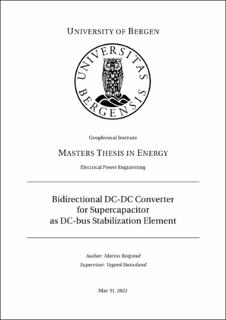Bidirectional DC-DC Converter for Supercapacitor as DC-bus Stabilization Element
Master thesis
Permanent lenke
https://hdl.handle.net/11250/2760974Utgivelsesdato
2021-06-01Metadata
Vis full innførselSamlinger
- Master theses [123]
Sammendrag
The demand for renewable energy from wind and solar is increasing. These energy sources are intermittent and unpredictable to a degree and require a stable but fast responding DCgrid. This is achieved by extending the requirements of the DC-grid to its stabilization element and introducing high power density energy storage. The supercapacitor is investigated in this regard to be utilized as a stabilization element. Its fast electric response makes the supercapacitor an excellent energy storage device that works well with other energy storage devices like batteries and fuel cells but also standalone. An isolated bidirectional DC-DC converter is necessary to control the supercapacitor’s power flow and utilize its advantages fully. Firstly, an isolated bidirectional DC-DC converter is simulated and integrated with a supercapacitor in Matlab®/Simulink® to meet a specific system requirement. The DC-DC converter is presented with the dual active bridge topology and single-phase-shift control strategy. Based on the results, it is investigated if the supercapacitor is a good stabilization element for a DC-microgrid. Secondly, a supercapacitor system with integrated cell management, current and voltage sensing, over-voltage protection, and compact design is developed. The design is flexible, where one module can be connected in series or parallel to fit a custom design. In this thesis, six modules are necessitated to meet the system requirement. It is desirable to first test a prototype of one module before assembling the entire energy storage. The supercapacitor prototype is tested in the lab with a DC-load, and its transient response is compared with a simulated supercapacitor. A conference paper on the topic of supercapacitor and lithium-ion batteries is submitted for IEEE ICECCME2021. This paper presents our results that visualize the difference in transient response between the simulated and physical energy storage devices.
